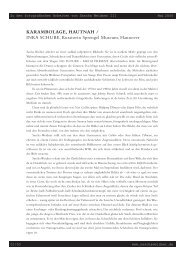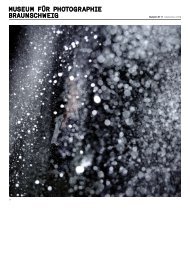WAS ES DIR BEDEUTET WHAT IT MEANS TO YOU - Sascha Weidner
WAS ES DIR BEDEUTET WHAT IT MEANS TO YOU - Sascha Weidner
WAS ES DIR BEDEUTET WHAT IT MEANS TO YOU - Sascha Weidner
Erfolgreiche ePaper selbst erstellen
Machen Sie aus Ihren PDF Publikationen ein blätterbares Flipbook mit unserer einzigartigen Google optimierten e-Paper Software.
Räume, des Archivs I und der Raum-Erzählung, durchwandern<br />
die Besucher somit <strong>Weidner</strong>s künstlerische Methode, aus<br />
neuen Bildern oder nur aus einer neuen Idee im Rückgriff auf<br />
das große Ganze des Archivs jeweils neue narrative Konstellationen<br />
zu formen. Zugleich erfährt man anschaulich, wie die<br />
unterschiedliche Auswahl und Zusammenstellung von Bildern<br />
auch deren jeweilige Bedeutung und Dechiffrierbarkeit bestimmen.<br />
Die Aufnahme des zerwühlten Lakens beispielsweise,<br />
die als einzelner Abzug ebenso Zeichen von sexueller Lust sein<br />
könnte, erscheint im Kontext dieser Erzählung und als großer<br />
Abzug hinter Acrylglas wie das Bild eines Leichentuchs.<br />
Things for What Else They Are 4<br />
<strong>Sascha</strong> <strong>Weidner</strong>s künstlerische Praxis des systematischen<br />
Verwebens von bestehenden und neuen Bildern in jeweils unterschiedliche<br />
Erzählungen ist repräsentativ für eine jüngere<br />
Generation von Fotografen, die die Distinktion zwischen gefundenen<br />
und inszenierten Bildern längst aufgegeben hat. So spielt<br />
<strong>Weidner</strong>s Bilderpool auch in der Hinsicht eine wichtige Rolle,<br />
dass Fotografien immer wieder zum Gegenstand von neuen Inszenierungen<br />
werden. Das Archiv als Ort der eigenen Geschichte<br />
wird somit produktiv ins Verhältnis zur Wahrnehmung des Jetzt<br />
gesetzt. Die neue Freiheit, den Kanon des Fotografier- und Ausstellbaren<br />
zu erweitern, hat sich <strong>Sascha</strong> <strong>Weidner</strong> wie kaum ein<br />
anderer dieser Generation zu Eigen gemacht. In Abkehr zur distanzierten<br />
und sachlichen Ästhetik einer Fotografen-Generation<br />
zuvor spielen seine Sichtweisen auf die Faszination des Kindes<br />
an, die Welt zu entdecken. Ohne Angst davor, eine Blöße zu zeigen,<br />
begibt er sich auf die romantische Suche nach dem Einklang<br />
mit der Natur, versenkt sich in die Melancholie abgewandter Figuren,<br />
offenbart das Begehren nach dem Körper des Anderen.<br />
Zugleich erkunden seine Aufnahmen das »Optisch-Unbewusste«<br />
der Makrowelt und entdecken eine geheime Verwandtschaft<br />
in den Objekten des Alltags. <strong>Sascha</strong> <strong>Weidner</strong> transferiert eine<br />
fotografische Haltung in die Jetztzeit, die Minor White einmal so<br />
beschrieb: »When I looked at things for what they are, I was fool<br />
enough to persist in my folly and found that each photograph<br />
was a mirror of my Self«. Doch was zeigt der fotografische Spiegel<br />
– und dies war Gegenstand des Experiment –, wenn andere<br />
als der Fotograf hineinblicken hineinblicken?<br />
Was übrig blieb<br />
Für gewöhnlich sollten Ausstellungen spätestens mit dem<br />
Pressegespräch fertig sein, aber diese Ausstellung begann<br />
mit ihrer Eröffnung am 18. September erst zu arbeiten, blieb<br />
in permanenter Veränderung und fand ihre definitive Form am<br />
letzten Tag. Welche Erkenntnisse lassen sich aus der sukzessiven<br />
Verwandlung der Archive und aus den »Migrationsbewegungen«<br />
der Bilder ziehen? Als erstes fielen jene Bilder auf, die<br />
im Archiv I verschwunden waren und daraufhin als Farbflecke<br />
aus der großen weißen Fläche der Bildrückseiten herausleuchtend<br />
dem Besucher in Archiv II ins Auge sprangen. Es ist nicht<br />
verwunderlich, dass sich darunter bekannte Einzelbilder von<br />
<strong>Sascha</strong> <strong>Weidner</strong> befanden, etwa das Porträt der Schauspielerin<br />
Julie Delpy [942 | 0210] oder der junge Narziss [24 | 0350],<br />
der kopfüber vom Baum hängend den Wasserspiegel berührt.<br />
Zu den Fotografien, die rasch ihre neuen Besitzer fanden, zählten<br />
auch die Bilder, die man gemeinhin als gefälligere Motive<br />
bezeichnen würde, darunter die blauen Bilder des Himmels<br />
und des Meeres. Doch mindestens ebenso aufschlussreich<br />
wie das Studium dieser Bilder war es, im Laufe der Ausstellung<br />
das Verhalten der Besucher zu beobachten, beginnend mit der<br />
Schar jener Bildhungrigen, die am ersten Tag der Entnahme,<br />
kurz vor der Öffnung des Museums, in einer kleinen Schlange<br />
anstanden, um sich ein bereits am Abend der Eröffnung ent-<br />
38 <strong>WAS</strong> <strong>ES</strong> <strong>DIR</strong> <strong>BEDEUTET</strong> / <strong>WHAT</strong> <strong>IT</strong> <strong>MEANS</strong> <strong>TO</strong> <strong>YOU</strong><br />
decktes Bild zu sichern. Die Möglichkeit des Mitnehmens (verändert)<br />
den Blick auf die Bilder extrem [405 | 0594], und viele<br />
Besucher verbrachten mehr als eine halbe Stunde im Archiv I.<br />
Aus einigen ihrer Äußerungen klingt etwas wie eine heimliche<br />
Überzeugung heraus, dass das »eine Bild« auf sie warten würde:<br />
Gesehen / Gedanke: MEINS! Bin überrascht, dass man aus<br />
so einer großen Vielfalt tatsächlich sofort sagen kann, dieses<br />
eine Bild spricht mich an … [242 | 0484] schreibt eine 50-jährige<br />
Besucherin und ein 42-jähriger Mann bemerkt: Ich habe<br />
einige Runden durch den Archivraum gedreht, aber an diesem<br />
Bild bin ich immer wieder angekommen [750 | 0303]. Doch vor<br />
den 148 verbliebenen Bildern im Archiv I haben auch die ca.<br />
1300 Besucher vergeblich ihre vielen Runden gedreht, sie sind<br />
das, was übrig bleibt, die »Paria« im Archiv des Fotografen. In<br />
der Tat scheinen diese Fotos zu hermetisch; Blicke, die oftmals<br />
auf den Boden gerichtet sind: Kleider in einer dunklen<br />
Ecke, gebrauchte Kondome in einem Gebüsch, Mülltüten, leergegessenes<br />
Plastikgeschirr, blutverschmierte Taschentücher,<br />
Selbstporträts mit Hemden über dem Gesicht. Es sind die Spuren<br />
von vergangenen Ereignissen, persönliche Protokolle, die<br />
sich als Bildbausteine und Chiffren in <strong>Weidner</strong>s autobiografische<br />
Erzählstruktur einbinden lassen, die jedoch als Einzelbilder<br />
nur bedingt den Betrachter zur Identifikation einladen.<br />
Sie scheinen in der Tat nur dem Fotografen selbst etwas zu<br />
bedeuten.<br />
Modi des Blicks<br />
Studiert man die 658 Statements, die von den Besuchern zurückgelassen<br />
wurden, so zeichnen sich unterschiedliche Modelle<br />
ab, wie die Bilder ihre Betrachter für sich eingenommen<br />
haben oder wie sich die Betrachter die Bilder selbst zu eigen<br />
machten, wobei diese Modi der Betrachtung durchaus fließend<br />
ineinander übergehen. Grundsätzlich jedoch lassen sich<br />
zwei prinzipielle Typen feststellen, zum einen das »Projektionsmodell«,<br />
zum anderen das »beschreibend-analysierende<br />
Modell der Betrachtung«. Das »Projektionsmodell« zeichnet<br />
sich durch assoziative Momente aus, die ausgehend von bestimmten<br />
Qualitäten eines Fotos (Details, Farben, etc.) ein Bild<br />
im Betrachter wachrufen, bei dem nicht selten eine Art Äquivalenz-Relation<br />
der wahrgenommen Stimmung eines Bildes<br />
zur empfundenen oder vergangenen eigenen Lebenswirklichkeit<br />
besteht: ich hab das Bild ausgesucht, weil es mich an mein<br />
Leben grad erinnert. Steinig, uneben, voller Höhen und Tiefen<br />
[823 | 0437]. Das vorherrschende Verb in diesem Modus ist »jemanden<br />
an etwas erinnern«.<br />
Innerhalb des »beschreibend-analytischen Modells« ist die<br />
Haltung der Betrachter sehr viel unterschiedlicher. Ein häufiger<br />
Zugang ist die rein visuelle Freude an manchen Bildern,<br />
was durch die häufige Wendung »spricht mich an« zum Ausdruck<br />
kommt. Das Nebeneinander dieser beiden Modelle (persönlicher<br />
Bezug/ ästhetisches Gefallen) kommt etwa in der<br />
folgenden Äußerung einer 30-Jährigen zum Ausdruck: Eine<br />
Auswahl fällt schwer: Nehme ich ein Bild, dessen Farbe mich anspricht?<br />
Oder suche ich ein interessantes Motiv? Soll es ein Bild<br />
sein, das andere anspricht, wenn sie es bei mir in der Wohnung<br />
stehen sehen? Oder soll es eines sein, das mich selbst irgendwie<br />
berührt, das mit mir persönlich zu tun hat? (…) [545 | 0685].<br />
Die Bezugnahmen auf die Bilder innerhalb des beschreibendanalytischen<br />
Modells sind nicht selten kunsthistorischer (Das<br />
dramatische Hell / Dunkel mag ich sehr. Sieht aus wie auf einem<br />
niederländischen Stilleben (Willem Kalf), [751 | 0507]) oder formalästhetischer<br />
Natur (Es ist ruhig, quadratisch und ROT! [326<br />
| 0026]). Manche der interpretierenden Statements, wie etwa<br />
das folgende einer 53-jährigen Besucherin, suchen die Korrespondenz<br />
zum Titel: Was übrig bleibt! Für mich ist hier das Va-<br />
placed in relation to the perception of now. Like hardly anyone<br />
else of this young generation, <strong>Sascha</strong> <strong>Weidner</strong> has embraced<br />
the new freedom to expand the canon of what can be photographed<br />
and exhibited, to combine what one comes across and<br />
what one stages. In a move away from the distanced and objective<br />
aesthetics of the previous generation of photographers, his<br />
views play on a child’s fascination with discovering the world.<br />
Not afraid of exposing himself, he sets out on a romantic quest<br />
for harmony with nature, absorbs himself in the melancholy of<br />
abandoned figures, reveals the desire for the body of the Other.<br />
His photographs at the same time explore the »optical unconscious«<br />
of the macro-world and discover a secret kinship in the<br />
objects of everyday life. <strong>Sascha</strong> <strong>Weidner</strong> transports a photographic<br />
attitude into the present time, one which Minor White<br />
once described as follows: »When I looked at things for what<br />
they are, I was fool enough to persist in my folly and found that<br />
each photograph was a mirror of my Self.« But what does the<br />
photograph mirror – and this was the object of the experiment<br />
– when people other than the photographer look into it?<br />
What Remained<br />
Normally, exhibitions should be complete at the latest when<br />
they are opened to the press, yet this exhibition did not even<br />
begin to work until its opening on September 18; it changed<br />
constantly and took on its definitive form on its last day.<br />
What insight can be won from the successive transformation<br />
of the archives and the »migration« of the images? What first<br />
stood out were those photographs that had disappeared from<br />
Archive I and consequently grabbed the visitors’ attention<br />
as patches of color on the expansive white surface composed of<br />
the reverse sides of images in Archive II. It is not surprising that<br />
these included well-known individual images by <strong>Sascha</strong> <strong>Weidner</strong>,<br />
such as the portrait of the actress Julie Delpy [942 | 0210]<br />
or the young Narcissus [24 | 0350], who is hanging upside down<br />
from a tree and touching the surface of the water. Among the<br />
photographs that quickly found new owners were also images<br />
one would commonly refer to as more pleasing motifs, including<br />
blue pictures of the sky and the sea. Yet what was just as<br />
revealing as the study of these images was to observe the visitors’<br />
behavior during the exhibition, beginning with the flock of<br />
people eager to take a picture home on the first day they could<br />
be removed, standing in line just before the museum opened in<br />
order to secure the photograph they espied on the evening of<br />
the opening. Being able to take it home extremely alters one’s<br />
view of the images [405 | 0594], and numerous visitors spent<br />
more than half an hour in Archive I. In some of their statements<br />
it sounds like they were secretly convinced that the »one picture«<br />
had been waiting for them: Saw it / Thought: MINE! I’m<br />
surprised that out of such a wide variety, one can actually immediately<br />
say that this one picture appealed to me ... [242 | 0484]<br />
writes a 50-year-old woman, and a 42-year-old man remarks:<br />
I walked through the archive space several times, but I time and<br />
again stopped at this photo [750 | 0303]. But the ca. 1,300 visitors<br />
to the exhibition unavailingly walked past the 148 residual<br />
images in Archive I. They are what remains, the »outcasts« in<br />
the photographer’s archive. Indeed, these photographs seem<br />
to be too hermetic; glances that are often directed toward the<br />
ground: clothes in a dark corner, used condoms in a bush, garbage<br />
bags, used plastic dishes, bloody tissues, self-portraits<br />
with shirts over their faces. They are traces of past events; personal<br />
records that as pictorial components and codes can be<br />
integrated into <strong>Weidner</strong>’s autobiographical narrative structure,<br />
but which as individual images only in part prompt the viewer<br />
to identify with them. Indeed, they only seem to mean something<br />
to the photographer himself.<br />
Modes of Vision<br />
If one reviews the 658 statements left behind by the visitors,<br />
various models become apparent of how the images won favor<br />
with their viewers or how the viewers appropriated the pictures,<br />
whereby these modes of vision merge seamlessly into<br />
one another. However, there are basically two principal types:<br />
firstly, there is the »projection model,« and secondly, the »descriptive-analytical<br />
model of examination.« The »projection<br />
model« is characterized by associative elements that, based<br />
on certain qualities of a photo (details, colors, etc.), evoke an<br />
image in the viewer’s mind with which there is often a kind of<br />
equivalence relation between the perceived mood of the image<br />
and a person’s own perceived or past reality: I selected the picture<br />
because it reminds me of my own life. Stony, rough, full of<br />
highs and lows [823 | 0437]. The dominant verbal phrase in this<br />
mode is »to remind someone of something.«<br />
Within the »descriptive-analytical model,« the viewer’s attitude<br />
is much more varied. A frequent approach is the purely visual<br />
pleasure in some images, which is expressed by the recurring<br />
use of »appeals to me.« A juxtaposition of these two models<br />
(personal relation/aesthetic appreciation) is expressed, for instance,<br />
in the following statement made by a 30-year-old woman:<br />
It’s difficult to make a choice: should I take a picture whose<br />
color appeals to me? Or should I seek out an interesting motif?<br />
Should it be a picture that appeals to others when they see it in<br />
my apartment? Or should it be one that somehow touches me,<br />
that has something to do with me personally? … [545 | 0685].<br />
The references made to images within the descriptive-analytical<br />
model are often of an art-historical ( I really like the dramatic<br />
light/dark. It reminds me of a Netherlandish still life (Willem<br />
Kalf), [751 | 0507]), or of a formal-aesthetic nature (It is calm,<br />
square, and RED! [326 | 0026]). Some of the interpretive statements,<br />
such as the following made by a 53-year-old woman,<br />
seek out a correspondence with the title: what remains! For me,<br />
the vanitas motif is wonderfully expressed here ... [561 | 0132].<br />
Others, on the other hand, emphasize an open, puzzling quality<br />
as the motivation for their choice: At first glance, I saw a smoky<br />
mountain in the picture. But when I looked at it more closely, it<br />
looked like a burning tree. (...) The picture ultimately fascinated<br />
me. It’s hard to put it into words [787 | 0553]. Does it have to be<br />
surprising – or rather, how can we explain that fact that more<br />
than double the number of those who made a statement are<br />
women? What is less surprising and more reassuring, on the<br />
other hand, is the power of photography to conjure up memories,<br />
which in the statements made by older visitors plays an<br />
important part and inspires them to write elaborate letters and<br />
stories. And last but not least, in several of the statements people<br />
reflect on the interesting phenomenon of this experiment,<br />
the reason for which is that one discovers one’s own memories<br />
in photographs taken by someone else. A 23-year-old woman<br />
writes: Dear <strong>Sascha</strong>, ... your pictures tell stories. Each one a<br />
different one. Some people seem to see themselves in stories.<br />
They’re your stories, which only you know. But they evoke memories,<br />
momentary emotions, and thoughts ... in me ... and touch<br />
my stories ... my thoughts [5 | 0962]. In this sense, the visitors’<br />
statements are responses without a sender to <strong>Weidner</strong>’s photographic<br />
messages without an addressee; anonymous Letters<br />
from the People, 5 annotations by unknown readers on the individual<br />
pages of a photographic autobiography.<br />
The Participation of the Observer<br />
If one looks for an explanation for the reaction to What Remains,<br />
one returns to the table that the artist made available for his<br />
visitors beneath a verse from Edith Piaf’s chanson Je ne regrette<br />
rien on the wall. Besides all the visual elegance and love of<br />
39






